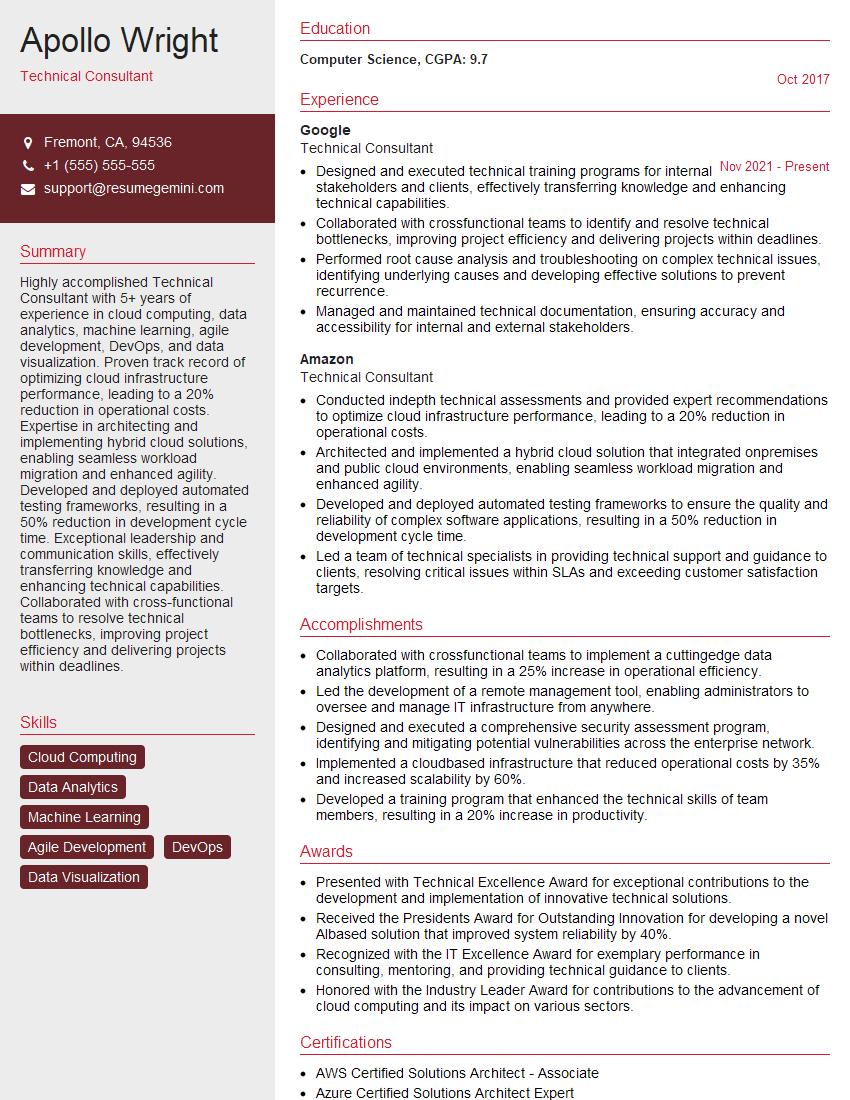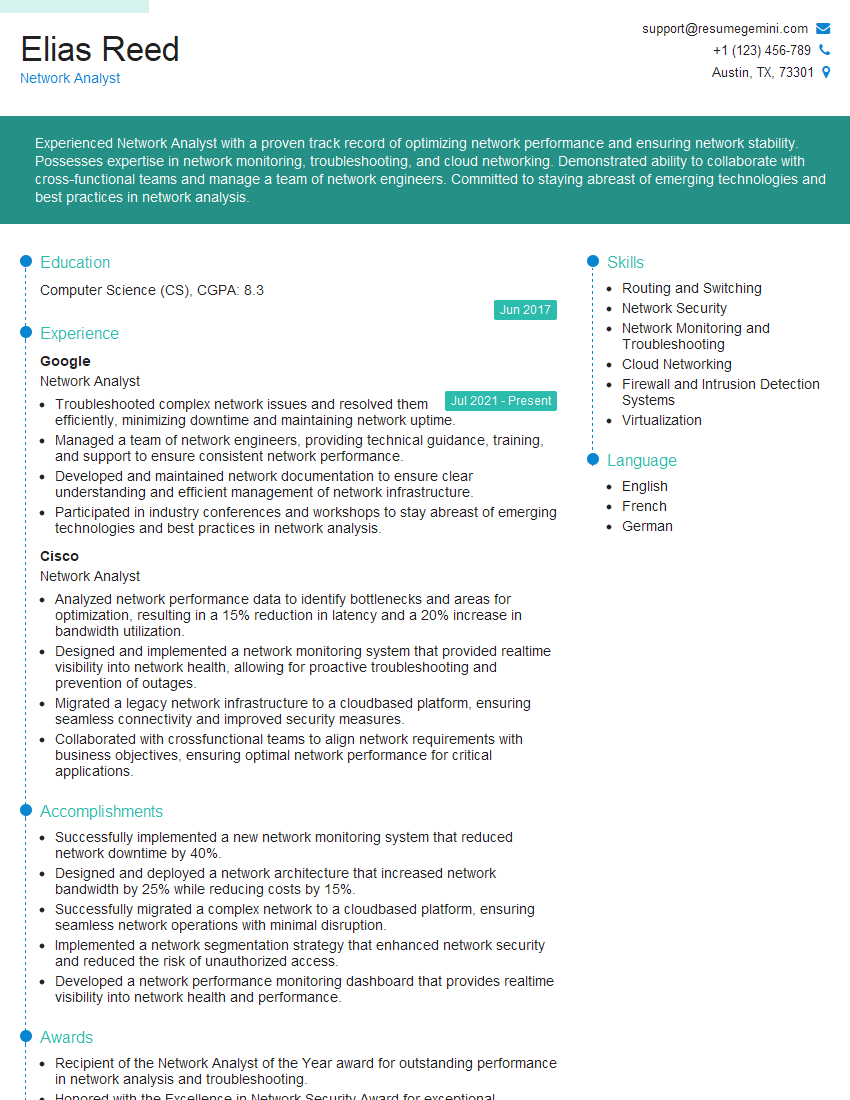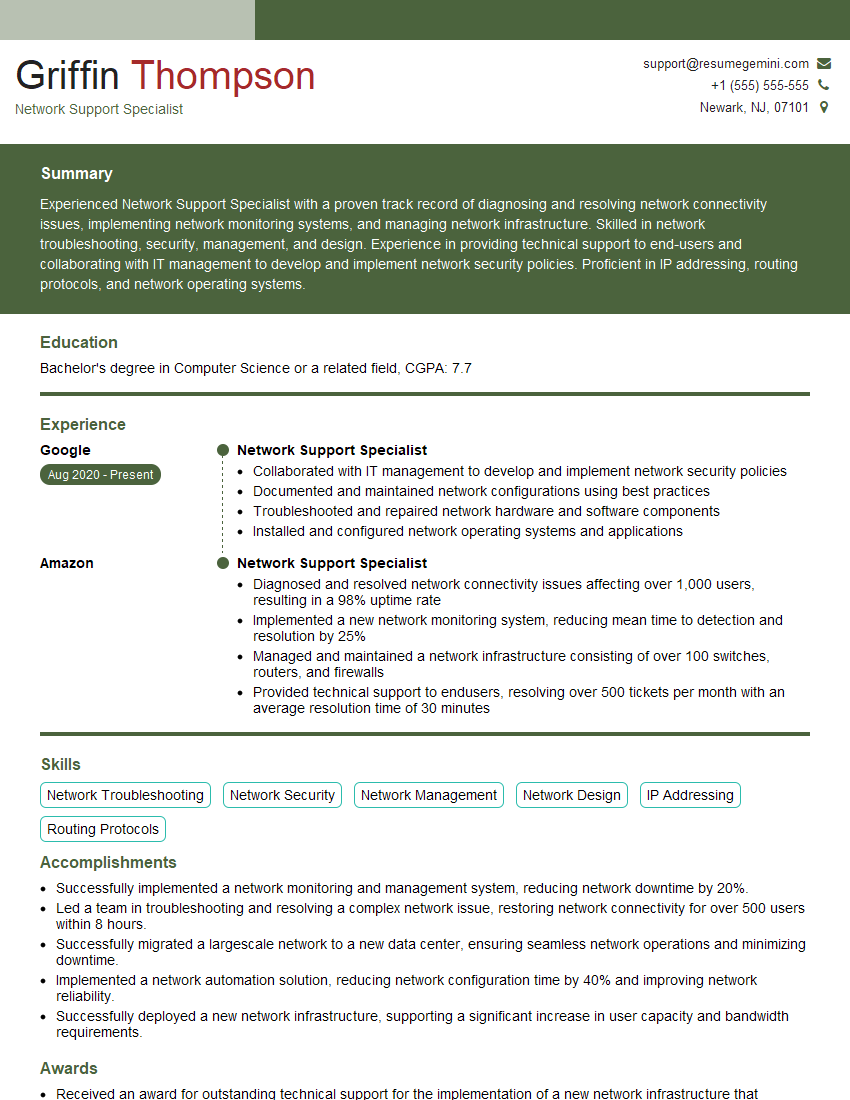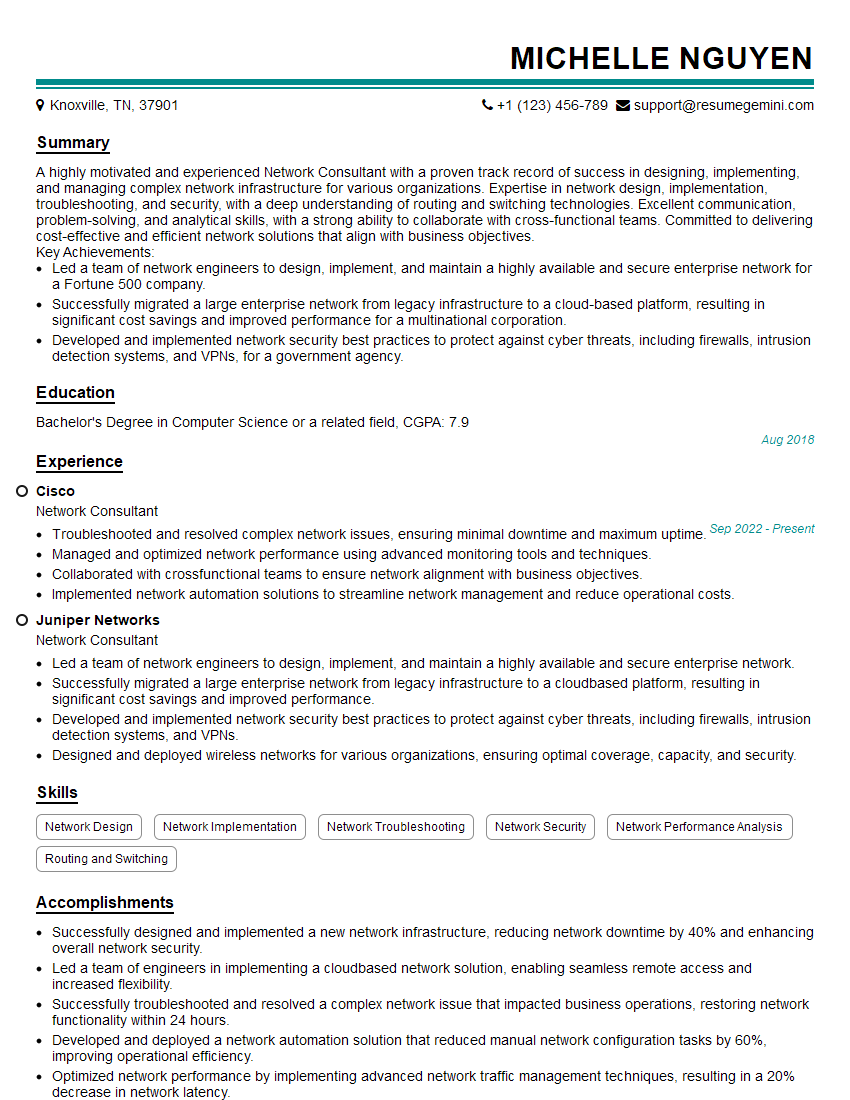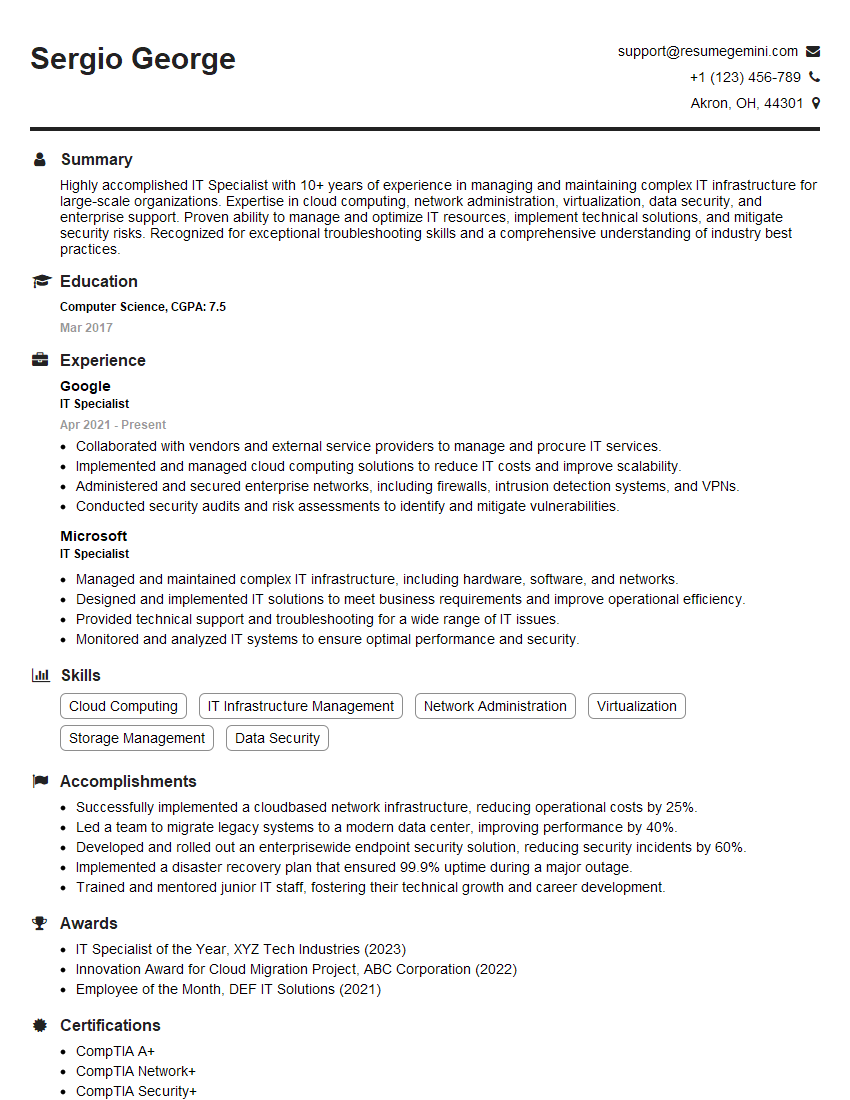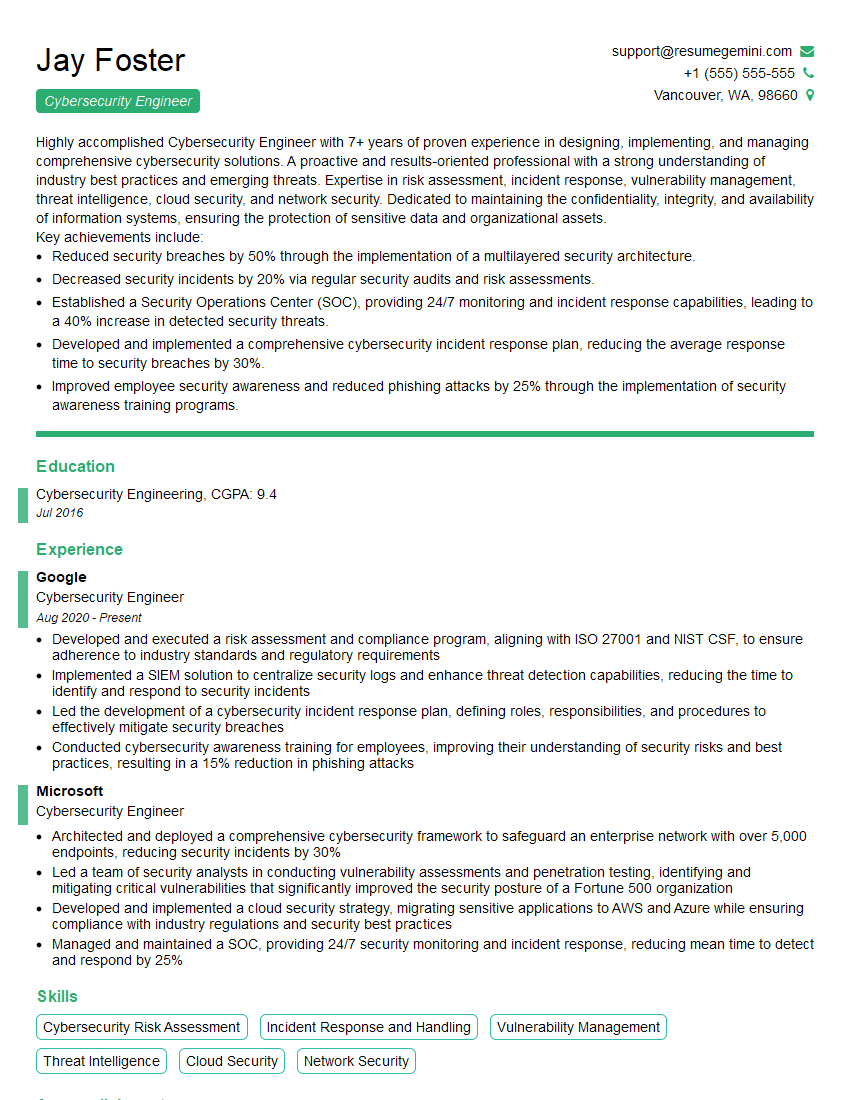Interviews are opportunities to demonstrate your expertise, and this guide is here to help you shine. Explore the essential Subnet Planning and Design interview questions that employers frequently ask, paired with strategies for crafting responses that set you apart from the competition.
Questions Asked in Subnet Planning and Design Interview
Q 1. Explain the concept of subnetting and its purpose.
Subnetting is like dividing a large apartment building into smaller, more manageable units. Instead of one giant network, subnetting breaks a large IP network into smaller, logically separate subnetworks. This improves network efficiency, security, and scalability. Each subnet gets its own smaller range of IP addresses, reducing broadcast traffic and improving performance.
The purpose is to control network traffic, improve security by isolating segments, and efficiently allocate IP addresses, especially when dealing with large organizations or networks with many devices.
Q 2. How do you calculate the number of subnets and usable hosts per subnet?
Calculating the number of subnets and usable hosts involves understanding binary numbers and subnet masks. Let’s say we have a Class C network with a /24 subnet mask (255.255.255.0). The number of bits borrowed from the host portion of the address determines the number of available subnets. The remaining host bits define the number of usable hosts per subnet.
- Number of subnets: 2number of borrowed bits. For example, borrowing 2 bits gives 22 = 4 subnets.
- Usable hosts per subnet: (2number of remaining host bits) – 2. The -2 accounts for the network address and broadcast address, which are not assignable to individual hosts. For example, with 6 remaining host bits, you get (26) – 2 = 62 usable hosts.
Example: If you borrow 3 bits from a /24 network, you get 23 = 8 subnets, and each subnet will have (2(8-3)) -2 = (25) – 2 = 30 usable hosts. This is because a /27 subnet mask will have 5 bits remaining for hosts.
Q 3. What is a subnet mask and how does it work?
A subnet mask is like a stencil that determines which part of an IP address represents the network portion and which part represents the host portion. It’s a 32-bit number (usually represented in dotted decimal notation like the IP address) that, when combined with the IP address, identifies the specific subnet a device belongs to.
It works by performing a bitwise AND operation between the IP address and the subnet mask. The result is the network address of the subnet. Any difference in the host portion indicates a different host on the same subnet.
Example: IP Address: 192.168.1.100, Subnet Mask: 255.255.255.0. The bitwise AND operation shows the network address is 192.168.1.0.
Q 4. Describe the difference between a Class A, Class B, and Class C IP address.
The classful IP addressing system (now largely obsolete due to the prevalence of CIDR) divided IP addresses into three classes based on the number of bits allocated to the network portion:
- Class A: Has 8 bits for the network address, leaving 24 bits for host addresses. Provides a very large number of hosts per network but only a small number of networks. Addresses start with 0-126.
- Class B: Has 16 bits for the network address and 16 bits for hosts. Provides a balance between the number of networks and hosts per network. Addresses start with 128-191.
- Class C: Has 24 bits for the network address and 8 bits for hosts. Provides a large number of networks but fewer hosts per network. Addresses start with 192-223.
It’s important to note that Classful addressing is largely historical, and Classless Inter-Domain Routing (CIDR) notation (/xx) is the standard now.
Q 5. Explain VLSM (Variable Length Subnet Masking) and its advantages.
Variable Length Subnet Masking (VLSM) allows for flexible allocation of IP addresses by using different subnet masks across a network. Instead of assigning the same subnet mask to all subnets within a larger network, VLSM uses varying subnet masks based on the number of hosts needed in each subnet.
Advantages:
- Efficient IP address utilization: You assign only the necessary number of IP addresses to each subnet, minimizing wastage.
- Improved security and traffic management: Smaller subnets are easier to manage and secure, reducing broadcast storms and improving overall network performance.
- Simplified network planning: VLSM simplifies complex network designs by allowing for more granular control over IP allocation.
Imagine a large company with different departments. Marketing might need 50 IP addresses, while engineering might need 200. VLSM efficiently accommodates this disparity, whereas traditional subnetting would waste addresses.
Q 6. How do you choose an appropriate subnet mask for a given network?
Choosing an appropriate subnet mask depends on the number of hosts you need per subnet. You start by determining the number of hosts required for each segment of your network. Then use the formula (2n) – 2, where ‘n’ is the number of host bits, to find the minimum number of bits needed. The result should be greater than or equal to the number of hosts required. You then subtract ‘n’ from 32 (the total number of bits in an IP address) to find the CIDR notation (/xx).
Example: You need 100 hosts. 27 = 128, 128 – 2 = 126. Therefore, you need at least 7 host bits. 32 – 7 = 25. So, the appropriate subnet mask is /25 (255.255.255.128).
Q 7. What are the challenges of designing large and complex subnet plans?
Designing large and complex subnet plans presents several challenges:
- IP Address Exhaustion: Efficiently allocating IP addresses across a large network is crucial. Poor planning can lead to running out of addresses quickly.
- Scalability: The subnet plan must accommodate future growth. Designing for expansion from the start is essential to avoid costly redesigns.
- Security: Securing a large network with many subnets requires careful planning. Segmentation and access control are crucial aspects.
- Troubleshooting: Identifying and resolving network problems becomes significantly more complex in a large network. Proper documentation and tools are necessary.
- Complexity Management: Managing a large network requires specialized tools and expertise. Automation and well-defined processes become essential.
To overcome these challenges, thorough planning, appropriate tools, and a well-defined network topology are essential. Using VLSM and proper documentation are also critical components of success.
Q 8. Describe your experience with CIDR notation.
CIDR, or Classless Inter-Domain Routing, notation is a way to represent an IP address and its associated subnet mask in a concise manner. It simplifies network addressing and routing by using a slash (/) followed by a number to represent the number of bits used for the network portion of the address. For example, 192.168.1.0/24 represents a network with a base IP address of 192.168.1.0 and a subnet mask of 255.255.255.0 (which is equivalent to 24 bits). The /24 indicates that the first 24 bits are the network address, leaving the remaining 8 bits for host addresses. My experience with CIDR involves extensive use in designing and implementing networks of varying sizes, from small office networks to larger enterprise-level infrastructures. I’ve used it for tasks including subnet planning, IP address allocation, and troubleshooting network connectivity issues. Understanding CIDR is crucial for efficient IP address management and preventing IP address conflicts.
In my previous role, I had to design a network for a rapidly growing company. Using CIDR notation, I was able to efficiently allocate IP addresses to different departments, ensuring that each department had sufficient IP addresses for its needs while preventing address conflicts. This allowed for seamless expansion and minimized the risk of network disruptions.
Q 9. Explain the concept of a default gateway.
A default gateway is the IP address of the router interface that a device uses to send packets to destinations outside its local network. Think of it as the address of the ‘exit’ from your local network. When your computer wants to communicate with a device on a different network, it sends the packet to its default gateway. The router then forwards the packet based on its routing table. Without a default gateway, a device can only communicate with other devices on its own subnet.
For example, if your computer has an IP address of 192.168.1.10 and a default gateway of 192.168.1.1, and you want to access a website, your computer will send the request to 192.168.1.1. The router at 192.168.1.1 will then forward the request to the internet.
Q 10. How do you troubleshoot subnet configuration issues?
Troubleshooting subnet configuration issues involves a systematic approach. I typically start by verifying IP address, subnet mask, and default gateway configurations on the affected devices. I use tools like ping to check basic connectivity, tracing routes with traceroute or tracert to identify points of failure. I also examine router configuration files for routing issues, looking for incorrect routing entries or access control lists (ACLs) that might be blocking traffic.
My approach often involves:
- Checking cable connections and network hardware for physical errors.
- Using network monitoring tools to examine packet loss and latency.
- Verifying the subnet mask is consistent across all devices on a given subnet.
- Ensuring the default gateway is correctly configured and reachable.
- Checking for IP address conflicts using tools like
arp -a. - Examining firewall rules to ensure they aren’t blocking necessary traffic.
A recent troubleshooting case involved a network segment experiencing intermittent connectivity. By meticulously checking each device’s configuration, I discovered a misconfigured subnet mask on a few client machines, causing them to incorrectly route traffic. Correcting the subnet mask resolved the issue immediately.
Q 11. What are the security implications of improper subnet planning?
Improper subnet planning poses significant security risks. Insufficient subnetting can lead to excessively large broadcast domains, increasing the attack surface. Broadcast storms can cripple network performance. Poorly planned subnets can also create unnecessary network segmentation, hindering security measures like firewalls and intrusion detection systems. Additionally, overlapping IP addresses can create conflicts and security vulnerabilities.
For instance, if a large network isn’t properly subnetted, an attacker who gains access to one device can potentially broadcast malicious traffic to a wide range of devices on the same large subnet, compromising numerous machines.
Q 12. Explain how subnetting impacts routing.
Subnetting significantly impacts routing by reducing the size of routing tables. Without subnetting, routers would have to manage huge routing tables, leading to inefficient routing and potential performance bottlenecks. Subnetting breaks down large networks into smaller, manageable subnets, reducing the number of entries needed in routing tables. This improves routing efficiency and reduces the complexity of network management.
Imagine a large office building. Without subnetting, the entire building would be considered a single network. Routing every packet within the building would be complex and inefficient. By subnetting, you divide the building into smaller, logically separated networks (floors, departments), significantly simplifying routing and improving network performance.
Q 13. Describe your experience with different routing protocols (e.g., OSPF, BGP).
I have extensive experience with OSPF (Open Shortest Path First) and BGP (Border Gateway Protocol), two widely used routing protocols. OSPF is a link-state routing protocol commonly used within autonomous systems (AS), offering efficient and fast convergence. BGP, on the other hand, is a path-vector routing protocol used between autonomous systems, enabling communication between different networks across the internet.
In previous projects, I’ve implemented OSPF to create a hierarchical routing structure within a large enterprise network. This allowed for efficient routing within the organization’s internal network. I’ve also used BGP to connect this internal network to the internet, ensuring seamless connectivity with external networks. My experience includes configuring, troubleshooting, and optimizing these protocols to ensure network stability and performance. Understanding their nuances, such as different routing metrics and administrative distances, is vital for creating robust and scalable network designs.
Q 14. How do you handle network address translation (NAT) in subnet design?
Network Address Translation (NAT) is crucial in subnet design, particularly when dealing with private IP address spaces. NAT allows multiple devices on a private network to share a single public IP address, conserving public IP addresses which are limited and expensive. In subnet design, I typically incorporate NAT at the edge of the private network, usually on a router or firewall. This allows devices within private subnets to access the internet while maintaining security and conserving public IP addresses.
For example, a small office might have a private network with many devices using 192.168.1.0/24. The router connecting this private network to the internet would use NAT to translate the private IP addresses to a single public IP address, allowing all devices to access the internet without needing individual public IP addresses for each machine. This approach is vital for improving security and managing IP addresses efficiently.
Q 15. What are the best practices for documenting subnet plans?
Thorough documentation is crucial for subnet plan success. Think of it like a blueprint for a house – you wouldn’t build without one! A well-documented subnet plan ensures smooth operation, easy troubleshooting, and efficient future expansion. My approach involves a multi-layered documentation strategy.
Network Diagram: A visual representation, using tools like Visio or Lucidchart, showing all subnets, routers, switches, and their interconnections. This provides a clear overview at a glance.
Subnet Table: A detailed table listing each subnet, its IP address range, subnet mask, default gateway, and assigned devices or departments. This is your go-to reference for IP address allocation.
IP Address Allocation Scheme: A clear explanation of how IP addresses are assigned within each subnet, including any reserved addresses for future use or specific services. This avoids conflicts and promotes organization.
Change Log: A record tracking all modifications made to the subnet plan, including dates, authors, and reasons for changes. This is vital for auditing and troubleshooting.
Documentation Repository: Storing all documents in a central, accessible location, preferably a version-controlled system (like Git) for easy access and collaboration.
For example, I once worked on a project where a poorly documented subnet plan led to hours of debugging and wasted resources. By implementing a comprehensive documentation strategy, we were able to avoid similar issues in subsequent projects.
Career Expert Tips:
- Ace those interviews! Prepare effectively by reviewing the Top 50 Most Common Interview Questions on ResumeGemini.
- Navigate your job search with confidence! Explore a wide range of Career Tips on ResumeGemini. Learn about common challenges and recommendations to overcome them.
- Craft the perfect resume! Master the Art of Resume Writing with ResumeGemini’s guide. Showcase your unique qualifications and achievements effectively.
- Don’t miss out on holiday savings! Build your dream resume with ResumeGemini’s ATS optimized templates.
Q 16. Describe your experience with network monitoring and management tools.
My experience with network monitoring and management tools is extensive. I’m proficient in using a variety of tools, adapting my approach based on the specific needs of the network.
SNMP (Simple Network Management Protocol): I utilize SNMP for collecting performance data from network devices, enabling proactive monitoring and early detection of issues.
Network Monitoring Systems (e.g., Nagios, Zabbix, PRTG): These tools allow me to centralize monitoring, set alerts for critical events, and gain a holistic view of network health.
Packet Analyzers (e.g., Wireshark): These are essential for troubleshooting network problems by capturing and analyzing network traffic. I often use these to pinpoint the root cause of connectivity issues or performance bottlenecks.
Configuration Management Tools (e.g., Ansible, Puppet, Chef): These tools enable automated network device configuration, ensuring consistency and reducing the risk of human error when deploying changes.
In a recent project, we implemented Zabbix to monitor our network infrastructure. By setting up appropriate alerts, we were able to detect and resolve a disk space issue on a critical server before it impacted users. This demonstrated the effectiveness of using monitoring tools to prevent outages.
Q 17. How do you ensure network scalability in your subnet design?
Network scalability is paramount in subnet design. It’s about building a network that can handle increasing demands without significant performance degradation or requiring complete redesigns. I achieve this through several strategies.
Hierarchical Subnetting: Dividing the network into smaller, manageable subnets, allowing for controlled growth within each segment. This prevents a single point of failure and simplifies troubleshooting.
Address Space Planning: Allocating ample IP address space to accommodate future expansion. This involves using CIDR notation efficiently and reserving IP addresses for future use. For example, starting with a /22 network gives you more flexibility than a /24.
Modular Design: Designing the network in modules, allowing for the easy addition or removal of network segments as needed. This enables incremental upgrades without disruption to the existing infrastructure.
Virtualization: Utilizing virtual machines and network virtualization technologies to efficiently utilize resources and scale computing power as needed.
Imagine designing a city – you wouldn’t build it all at once. A scalable network design works similarly, allowing for planned expansion without major disruptions.
Q 18. What is the importance of network redundancy in subnet planning?
Network redundancy is crucial for ensuring high availability and minimizing downtime. It’s like having a backup plan – you hope you won’t need it, but you’re glad you have it when things go wrong.
Redundant Routers and Switches: Using multiple routers and switches to provide backup paths in case of failure. This prevents network disruptions if a single device goes down.
Redundant Links: Employing multiple connections between network segments to provide alternative paths for data transmission. This is often achieved through spanning-tree protocols.
Redundant Power Supplies: Having backup power supplies (UPS or generators) to ensure continued operation in the event of a power outage.
For instance, in a data center environment, redundancy is absolutely vital. Redundant routers, switches, and power supplies ensure business-critical applications remain online even during hardware failures.
Q 19. Explain your understanding of IPv4 and IPv6 subnetting.
Both IPv4 and IPv6 are internet protocol addressing schemes, but they differ significantly in their addressing structure and size. IPv4 uses 32-bit addresses, while IPv6 uses 128-bit addresses, providing a vastly larger address space.
IPv4 Subnetting: Involves dividing a larger IP address range into smaller subnets using subnet masks. The subnet mask identifies the network portion and the host portion of the IP address. For example, a
192.168.1.0/24network can be subnetted into smaller networks using masks like/25,/26, etc.IPv6 Subnetting: Uses a similar concept, but with a much larger address space. IPv6 subnetting typically involves using variable-length subnet masks (VLSM) to create subnets of different sizes as needed. The notation is also different: instead of /24, you might see /64 for example, indicating the number of leading bits that define the network portion.
The transition from IPv4 to IPv6 is an ongoing process, and understanding both is crucial for network administrators. Many networks today operate with both IPv4 and IPv6 concurrently.
Q 20. How do you handle overlapping subnets?
Overlapping subnets are a major problem. They result in routing conflicts and communication failures. It’s like having two houses with the same address – the mailman wouldn’t know where to deliver!
The solution is straightforward: identify and correct the overlapping IP address ranges. This might involve:
Careful IP Address Planning: Ensuring that IP addresses are assigned uniquely across all subnets. Use a subnet calculator or IP address management (IPAM) tool to assist in this.
Subnet Mask Verification: Double-checking the subnet masks to make sure they are correctly configured and don’t create overlapping address spaces.
Network Scanning: Performing a network scan to identify devices with conflicting IP addresses.
Manual Reclassification: Manually re-assigning IP addresses to resolve the conflict. This requires careful planning to minimize disruption.
Prevention is key. Thorough subnet planning and careful documentation can prevent overlapping subnets from happening in the first place.
Q 21. How do you plan for future growth in your subnet design?
Planning for future growth is essential for any successful subnet design. It’s better to be prepared than to react to unexpected growth with costly and disruptive changes.
Over-provisioning: Allocating more IP addresses than currently needed. This provides a buffer for future expansion without requiring immediate changes.
Modular Design: Adopting a modular design, allowing for the addition of new subnets or network segments as needed. This makes it easy to incorporate new devices or departments.
Scalable Infrastructure: Using network devices and technologies that can be easily scaled, such as virtual routers and switches.
Regular Reviews: Conducting regular reviews of the subnet plan to assess future needs and make necessary adjustments.
Think of it like designing a road network for a growing city. You wouldn’t design just enough roads for today’s traffic; you’d plan for future expansion to avoid congestion and allow for growth. A well-planned subnet design follows the same principle.
Q 22. What are the different types of subnet masks?
Subnet masks are crucial for defining the network portion and the host portion of an IP address. They’re essentially 32-bit numbers, usually represented in dotted decimal notation (e.g., 255.255.255.0), that act as a filter. Different types arise from how this filtering is done, influencing the number of subnets and hosts within each subnet.
- Classful Subnet Masks: These were the older, simpler approach. Class A networks used a mask of
255.0.0.0, Class B used255.255.0.0, and Class C used255.255.255.0. While straightforward, they were inflexible and wasteful in terms of IP address allocation. - Classless Inter-Domain Routing (CIDR) Notation: This is the modern standard, represented as
/nwherenis the number of bits used for the network portion of the address. For example,/24means the first 24 bits represent the network, leaving 8 bits for hosts (giving you 254 usable host addresses per subnet). This provides far more flexibility and allows for efficient subnet design. - Variable Length Subnet Masking (VLSM): VLSM is a technique using CIDR notation to create subnets of varying sizes based on the specific needs of each part of the network. This is incredibly efficient and avoids wasting IP addresses. Imagine you need a subnet for a server room with just a few devices and another for a large department with many computers. VLSM allows you to create a small subnet for the server room (e.g.,
/29) and a larger one for the department (e.g.,/24).
Understanding these different types is critical for effective subnet planning, ensuring optimal resource utilization and preventing IP address conflicts.
Q 23. Describe a time you had to troubleshoot a complex subnetting issue.
In a previous role, we experienced an unusual network outage affecting a remote branch office. Initially, it seemed like a simple router failure. However, after replacing the router, the problem persisted. Through meticulous investigation, we discovered that the problem wasn’t with the hardware itself, but with an incorrectly configured subnet mask. The branch office’s subnet mask had been accidentally changed, leading to IP address conflicts with the main office network. This caused a complete communication breakdown.
My approach involved:
- Verifying Network Configuration: I systematically checked the IP addresses, subnet masks, and default gateways on all devices at the remote branch.
- Packet Capture Analysis: I used Wireshark to capture network traffic, identifying the source of the conflict. This revealed the erroneous subnet mask.
- Restoring Correct Configuration: Once the issue was identified, we restored the correct subnet mask, ensuring all devices were properly configured.
- Documentation Update: After resolving the issue, we updated our network documentation to prevent similar errors in the future.
This experience underscored the importance of precise subnetting and meticulous documentation for maintaining a robust and reliable network.
Q 24. Explain your experience with different network topologies.
I have extensive experience with various network topologies, including:
- Bus Topology: Simple, but suffers from single point of failure.
- Star Topology: Common, with a central hub or switch, offering better reliability.
- Ring Topology: Data flows in a circle, providing fault tolerance but complex to manage.
- Mesh Topology: Multiple paths between devices, highly reliable but expensive.
- Tree Topology: A hierarchical structure, often used in larger networks.
My experience extends to designing and implementing these topologies within both physical and virtual network environments. Understanding these topologies is vital for optimal subnet design, as the chosen topology directly impacts the placement of subnets and their connectivity.
For example, in a star topology, subnets can be easily segmented by assigning specific IP ranges to different ports on the central switch. In a mesh topology, multiple subnet overlaps might be necessary to accommodate redundancy.
Q 25. How do you ensure efficient utilization of IP addresses?
Efficient IP address utilization is crucial for minimizing waste and ensuring future scalability. Key strategies include:
- Careful Subnet Planning: Using VLSM to create subnets of varying sizes based on the needs of each network segment prevents wasting addresses on unnecessarily large subnets.
- Address Aggregation: This involves combining multiple smaller subnets into a single, larger subnet using CIDR notation, simplifying routing and reducing routing table entries. This is particularly useful when dealing with large network environments.
- IP Address Recycling: When devices are decommissioned, their IP addresses should be carefully tracked and reused within the same subnet. Proper inventory management is key here.
- Regular Network Audits: Periodically reviewing IP address usage helps identify unused addresses and potential areas for optimization.
By employing these strategies, I ensure that IP addresses are used responsibly and that the network has sufficient capacity to accommodate future growth without requiring a complete network redesign.
Q 26. What tools and technologies do you use for subnet planning?
I utilize a combination of tools and technologies for subnet planning, ensuring accuracy and efficiency. These include:
- Subnet Calculators: Online tools and software applications that perform subnet calculations quickly and accurately, eliminating manual calculations prone to error.
- Network Management Systems (NMS): These systems provide a central view of the network’s IP address usage, helping to track allocated and available IP addresses. Examples include SolarWinds Network Performance Monitor and PRTG.
- IP Address Management (IPAM) Software: Specialized software designed for efficient IP address management, including subnetting, allocation, and tracking. Examples are Infoblox and ManageEngine OpManager.
- Spreadsheet Software (Excel, Google Sheets): Useful for organizing subnet plans, documenting IP address assignments, and tracking network device configurations.
Combining these tools provides a comprehensive approach to subnet planning, ensuring accuracy and efficient management of IP addresses throughout the network lifecycle.
Q 27. How do you ensure your subnet design is secure and resilient?
Security and resilience are paramount considerations in subnet design. My approach integrates the following principles:
- Network Segmentation: Dividing the network into smaller, isolated subnets limits the impact of security breaches. If one subnet is compromised, the rest remain unaffected.
- Access Control Lists (ACLs): Implementing ACLs on routers and firewalls controls network traffic flow between subnets, preventing unauthorized access. This adds a layer of security and improves overall network resilience.
- Redundancy and Failover Mechanisms: Designing redundant network paths and implementing failover mechanisms ensures high availability in case of failures. This could involve multiple routers or switches across subnets.
- Regular Security Audits and Penetration Testing: Conducting regular security assessments and penetration tests identifies vulnerabilities in the network and subnet design, allowing for proactive mitigation of potential risks.
By integrating these security and resilience features into the subnet design from the outset, I create a robust and secure network that can withstand various threats and failures.
Q 28. Describe your experience with virtual networks and their subnetting.
I have significant experience with virtual networks and their subnetting, primarily using technologies like VMware vSphere, AWS VPC, and Azure Virtual Networks. The concepts of subnetting remain the same in virtual environments, but the tools and management differ.
In virtual networks, subnets are created logically, often using a dedicated IP range within the overall virtual network’s address space. This allows for granular control and isolation of virtual machines (VMs) within the virtual environment. The challenges are similar: efficient resource allocation, security isolation, and avoiding IP address conflicts. However, tools provided by the virtual network platforms (e.g., AWS console, Azure portal) facilitate IPAM and subnet configuration.
For example, in AWS VPC, you can easily create multiple subnets within a virtual private cloud (VPC), assigning specific IP ranges and security group rules to each subnet. This allows for organizing VMs by function (e.g., database servers in one subnet, web servers in another), enhancing security and manageability.
Key Topics to Learn for Subnet Planning and Design Interview
- IP Addressing and Subnetting: Understanding Classless Inter-Domain Routing (CIDR) notation, subnet masks, and calculating usable IP addresses within subnets. Practice converting between decimal and binary representations.
- Subnet Mask Selection and Design: Learn how to choose appropriate subnet masks based on network size and future scalability requirements. Consider factors like minimizing wasted IP addresses and maximizing efficiency.
- VLSM (Variable Length Subnet Masking): Mastering VLSM is crucial for optimizing IP address allocation. Be prepared to explain its advantages over traditional subnetting methods and demonstrate its application in diverse network scenarios.
- Network Diagrams and Documentation: Practice creating clear and concise network diagrams using standard notation. Understand the importance of thorough documentation for network maintenance and troubleshooting.
- Troubleshooting Subnet Issues: Be ready to discuss common subnet-related problems like incorrect subnet masks, IP address conflicts, and routing issues. Prepare examples of how you would approach and resolve these situations.
- Routing Protocols (Basic Understanding): While not the core focus, a foundational understanding of routing protocols like RIP and OSPF will demonstrate a broader networking context. Focus on how they interact with subnet design.
- Network Security Considerations: Discuss how subnet design impacts network security. Explain the importance of isolating sensitive network segments and implementing appropriate security measures.
Next Steps
Mastering subnet planning and design is essential for career advancement in networking and related fields. It demonstrates a strong understanding of networking fundamentals and the ability to create efficient and scalable network infrastructures. To increase your job prospects, create an ATS-friendly resume that highlights your skills and experience effectively. ResumeGemini is a trusted resource to help you build a professional and impactful resume. Examples of resumes tailored to Subnet Planning and Design are available to guide you. Take the next step towards your dream career today!
Explore more articles
Users Rating of Our Blogs
Share Your Experience
We value your feedback! Please rate our content and share your thoughts (optional).
What Readers Say About Our Blog
Hello,
We found issues with your domain’s email setup that may be sending your messages to spam or blocking them completely. InboxShield Mini shows you how to fix it in minutes — no tech skills required.
Scan your domain now for details: https://inboxshield-mini.com/
— Adam @ InboxShield Mini
Reply STOP to unsubscribe
Hi, are you owner of interviewgemini.com? What if I told you I could help you find extra time in your schedule, reconnect with leads you didn’t even realize you missed, and bring in more “I want to work with you” conversations, without increasing your ad spend or hiring a full-time employee?
All with a flexible, budget-friendly service that could easily pay for itself. Sounds good?
Would it be nice to jump on a quick 10-minute call so I can show you exactly how we make this work?
Best,
Hapei
Marketing Director
Hey, I know you’re the owner of interviewgemini.com. I’ll be quick.
Fundraising for your business is tough and time-consuming. We make it easier by guaranteeing two private investor meetings each month, for six months. No demos, no pitch events – just direct introductions to active investors matched to your startup.
If youR17;re raising, this could help you build real momentum. Want me to send more info?
Hi, I represent an SEO company that specialises in getting you AI citations and higher rankings on Google. I’d like to offer you a 100% free SEO audit for your website. Would you be interested?
Hi, I represent an SEO company that specialises in getting you AI citations and higher rankings on Google. I’d like to offer you a 100% free SEO audit for your website. Would you be interested?
good

